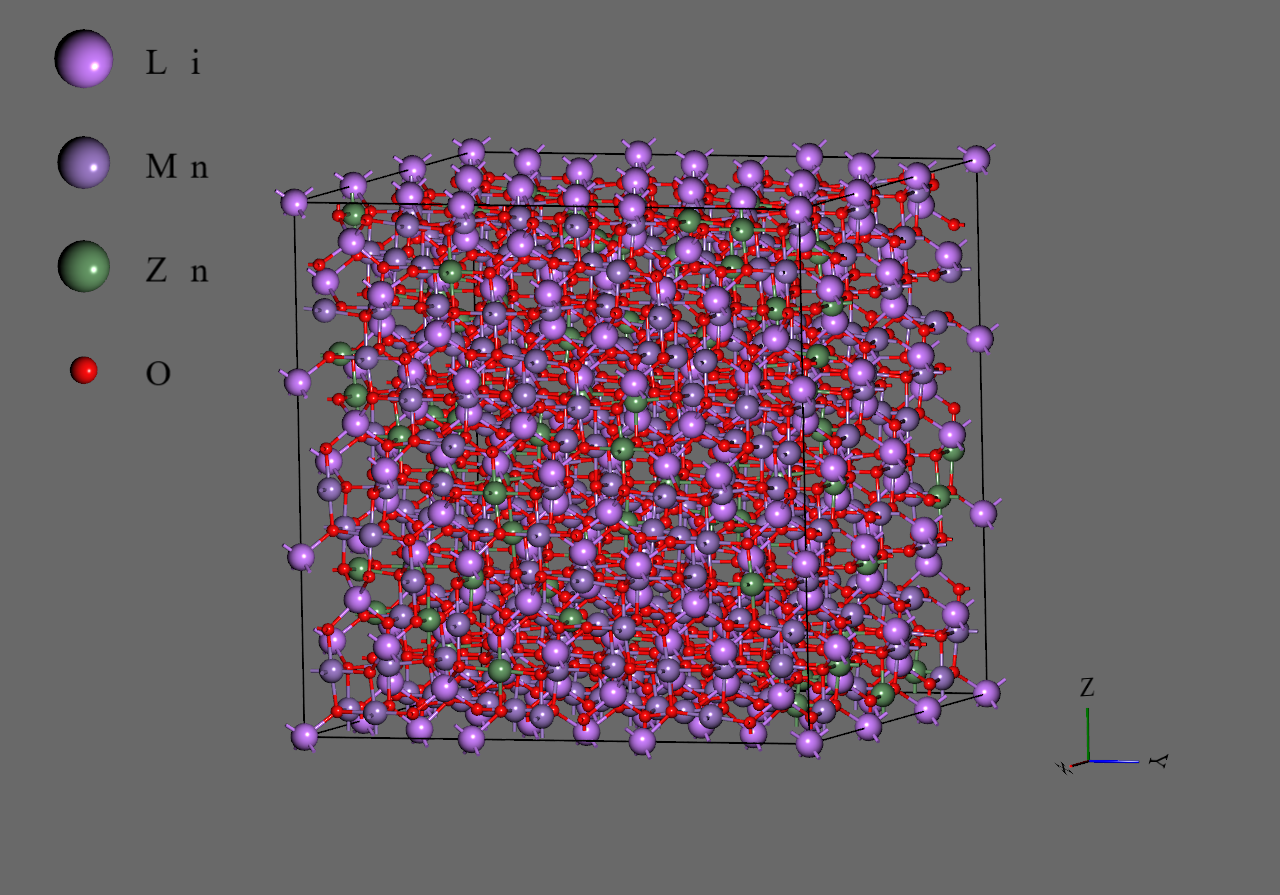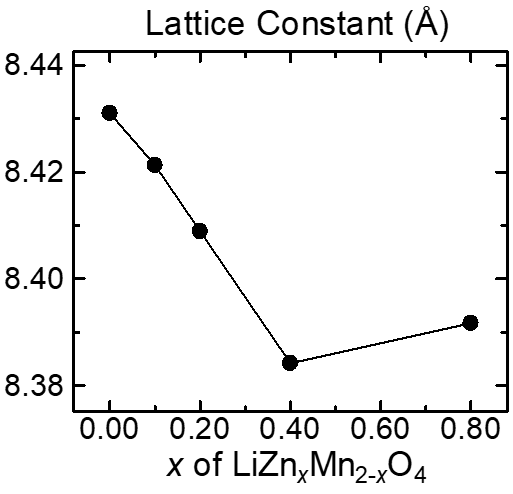Moleculer Dynamics Simulation of LiZnxMn2-xO4 using M3GNet#
M3GNet#
M3GNet is a new materials graph neural network potential including 3-body interactions. The main differences from prior material graph implementations such as MEGNet are the addition of atom coordinates and crystal 3×3 lattice matrices, which are required for automatic differentiation of tensor quantities such as forces and stresses.
M3GNet performs similarly to state-of-the-art machine learning potentials and accomplish a high degree of versatility, covering the entire periodic table via a graph representation.
Chen, C., Ong, S.P. A universal graph deep learning interatomic potential for the periodic table. Nat Comput Sci 2, 718–728 (2022). https://doi.org/10.1038/s43588-022-00349-3.
LiMn2O4#
Lithium ion manganese oxide LiMn2O4 is a spinel structure widely known as the cathode material of lithium-ion battery.

Structural Phase Transition#
LiMn2O4 structure changes from cubic at higher temperature to orthorhombic, forming 1×3×3 superlattice. This is caused by Jahn-Teller distortion of Mn3+O6 octahedron in LiMn2O4. Actually, both Mn3+ and Mn4+ existing locally and independently even in high temperature phase, it has been thought that the part where Mn3+O6 octahedron adjoins Mn4+O6 octahedron are locally distorted.
Hiromasa IKUTA, Yoshiharu UCHIMOTO, Masataka WAKIHARA, Crystal Structure Control of Lithium Manganese Spinel Oxides and Their Application to Lithium Secondary Battery, NIPPON KAGAKU KAISHI, 2002, 2002(3), pp. 271-280, https://doi.org/10.1246/nikkashi.2002.271
Substitution of Mn Atoms#
Increasing the ratio of Mn4+ by substituting some Mn with Co, Cr, Zn, etc. suppresses the Jahn-Teller distortion, which improves the stability of the cubic structure and lowers the transition temperature. It has also been reported that the lattice constants tends to decrease linearly as the substitution rate is increased.
Analysis Procedure#
M3GNet was applied to LiZnxMn2-xO4. Optimizing structures with changing the x value, the following two were analyzed.
- Energies of cubic and orthorhombic structures
- Lattice constants
Structure Creation#

The basis structures were imported from Materials Project(https://materialsproject.org/).
- Cubic (mp-22584)
- Orthorhombic (mp-1199729)
Structures for analysis were created by randomly substituting Mn to Zn based on the above structures. The number of each structures is given in the table below. Since the orthorhombic structure forms 1×3×3 supercell by Jahn-Teller distortion, 3×1×1 of orthorhombic structures were mapped to 3×3×3 cubic structures.
| x | 3×3×3 Cubic | 3×1×1 Orthorhombic |
|---|---|---|
| 0 | 1 | 1 |
| 0.1 | 5 | 5 |
| 0.2 | 5 | 5 |
| 0.4 | 5 | 5 |
| 0.8 | 5 | 5 |
Structural Optimization#
Structural optimization was performed while deforming the cell as follows.
| 3×3×3 Cubic | 3×1×1 Orthorhombic |
|---|---|
| Isotoropic | Anisotoropic |
Analysis Result#
Energies of Cubic and Orthorhombic Structures#
Calculating ΔEpot ( = Epotaniso - Epotiso ), the stability of cubic and orthorhombic structures can be evaluated relatively from the perspective of energy.
| x | ΔEpot (meV/atom) |
|---|---|
| 0 | -11.06 |
| 0.1 | -5.777 |
| 0.2 | -3.251 |
| 0.4 | 0.3868 |
| 0.8 | 0.2132 |
For x<0.4, the orthorhombic structure was energetically stable. In addition, since the absolute value of the energy difference decreased as the substitution ratio increased, it was expected that the transition temperature decreased. This simulation results showed the similar tendency as the experimental results.
As described above, M3GNet could qualitatively reproduce the behavior of the phase transition.
Anisotropy of Orthorhombic Structures#
Anisotropy of orthorhombic structures was evaluated as the ratio of the magnitudes of the lattice vectors.
| x | Cella | Cellb | Cellc |
|---|---|---|---|
| 0 | 1.0000 | 1.0090 | 1.0094 |
| 0.1 | 1.0000 | 1.0061 | 1.0078 |
| 0.2 | 1.0016 | 1.0000 | 1.0074 |
| 0.4 | 1.0000 | 1.0013 | 1.0018 |
| 0.8 | 1.0018 | 1.0001 | 1.0000 |
It was found that higher substitution ratio decreased the anisotropy of the orthorhombic structure. This results indicated the tendency that higher substitution ratio of Mn stabilized cubic structure similar to the evaluation by the energy differences.
Lattice Constants#
The lattice constants of cubic structures were evaluated.

For x≤0.4, It was observed that the lattice constant linearly decreased as substitution ratio increased.
Besides, for x=0.8, which exceeds the amount of substitution (x=0.5) where the average valence of Mn is +4, the results were deviated from the tendency of x≤0.4 region. It could be thought to happen because the decrease of the lattice constant was derived from the decrease of Mn3+.
The above results showed that M3GNet could reproduce the effect of suppressing Jahn-Teller strain by substituting Mn to Zn and the accompanying tendency of the decrease in the lattice constant.